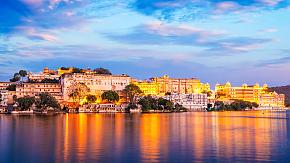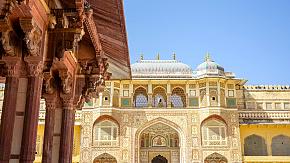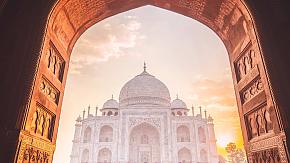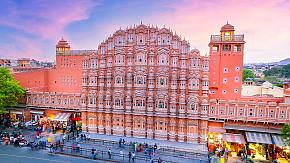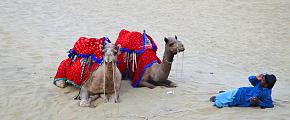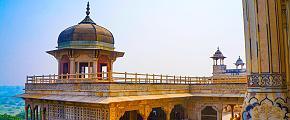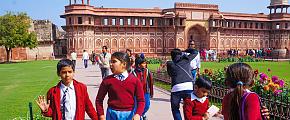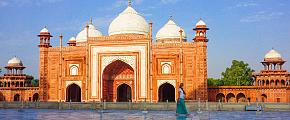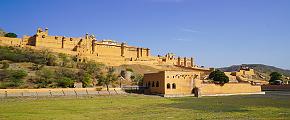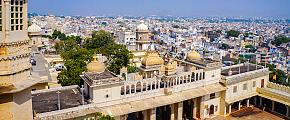11 Famous Temples in India
Indians have been devoted to the Almighty God and held a variety of faiths from ancient times. Before beginning a new career, people may pray to God for success. They may also ask for forgiveness when they feel guilty and remorseful after finishing work. As time went by, followers of numerous religions arrived in India. As a result, India is home to a wide range of temples. This article lists 11 temples in India that are well worth a visit when you take a trip to India.
Kashi Vishwanath Temple
As one the most important Hindu temples, it was constructed in memory of Shiva, who is the master of fertility and Lord of cattle among Hinduism deities. Situated at the river bank of the River Ganges, many believers will visit this temple and bath in the river since they consider these as the processes to be salvaged. Throughout its history, the temple has been rebuilt and renovated many times. The temple complex we see today, built from a large amount of gold, is believed to have been constructed by Ahalya Bai of the Holkar Dynasty. The temple is full of exquisite carvings. It should be noted that some shrines only allow Hindu devotees to enter.
Location: Vishwanath Gali, Varanasi, Uttar Pradesh 221001
Sri Harmandir Sahib Temple
The Sri Harmandir Sahib Temple was built in 1604 by the fifth Sikh guru Arjan, who purposely built it on a lower level so that even the most modest would have to walk down to enter. It is the most significant pilgrimage site for Sikhs and the principal place of devotion for Sikhism. Entrances are present on each of the four sides, signifying the temple's accessibility to devotees of all castes and religions. The temple has a long history of suffering and strife, having been destroyed in wars and rebuilt several times. Eventually, it was reconstructed between 1801 and 1839, during Maharajah Ranjit Singh's rule. The Golden Temple, as it is sometimes called, has a marble interior with traditional artwork and a gold-plated exterior.
Location: Golden Temple Road, Atta Mandi, Amritsar, Punjab 143006
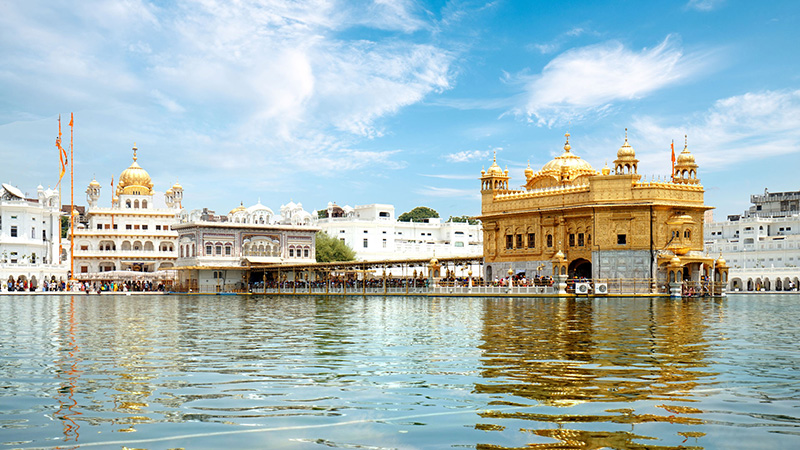 The Sri Harmandir Sahib Temple
The Sri Harmandir Sahib Temple
The Jagannath Temple
Jagannatha means the Lord of the World in Sanskrit. The main shrine of the temple was constructed in the eleventh century, making it one of the oldest Hindu temples still in operation. Throughout its history, the temple was administered and controlled by the Mahratta and the British. The busiest time of the year for the temple is the Chariot Festival, which usually takes place in June or July. Throughout the festival, the statue is loaded into a cart that is so heavy that it takes the combined might of hundreds of followers to push it across the thick sand to the god's rural home. Numerous days are required for the trek, which is taken by thousands of pilgrims.
Location: Temple Road, Puri, Odisha 752001
Tirupati Balaji Temple
Also known as the Venkateshwara Temple, this famous Hindu temple was dedicated to Lord Venkateshwara, an embodiment of Lord Vishnu. The temple rose to become one of the richest in the world as one of the most frequented sites of worship. The ruling god is standing and has four hands, two of which are holding the conch and chakra while the other one is in a blessing position resting on the thigh. The processional god Malayappa, accompanied by his consorts Sridevi and Bhudevi, is driven in a procession through the four streets around the temple during the festival of Brahmotsavam in various vehicles. The temple continues to practice hair donation. People of all ages do this ritual by offering prayers and shaving their heads close to the temple grounds. To facilitate individuals giving their hair to the Lord, the temple administration created large facilities.
Location: Tirupati, Andhra Pradesh 517501
Vaishno Devi Temple
One of the most popular Hindu pilgrimage sites in India is the Vaishno Devi Temple, which is situated in the foothills of the magnificent Trikuta Mountains. Numerous followers go from all over the world to the well-known holy location to seek the blessings of Goddess Vaishno Devi, who is reputed to grant their every request. Devotees offer customary gifts, such as flowers and dried fruits. Navaratri, a nine-night celebration honoring Devi's triumph over wicked demons, and Diwali, a festival of lights signifying the triumph of light over darkness, good over evil, and knowledge over ignorance, are the two most notable festivals celebrated at Vaishno Devi Temple. For the convenience of tourists, a total of three tunnels have been constructed to access the temple due to its popularity.
Location: Bhavan, Katra, Jammu and Kashmir (State) 182301
Somnath Temple
One of the titles of Lord Shiva is Somnath, which translates to the Lord of the Moon. Hindus restored the temple after it was repeatedly assaulted and damaged by Muslim invaders and rulers. The current Mandir that is seen was constructed in 1951. Sanskrit writing may be found in abundance on the temple's arrow wall. The temple is 155 feet tall and is made of sandstone. It has seven storeys. The 37-foot-long flag staff atop the temple changes the temple flag three times each day. No matter what faith you practice, everyone can go to the Somnath temple without needing a permit.
Location: Somnath Mandir Road, Prabhas Patan, Veraval, Gujarat 362268
Meenakshi Amman Temple
Being one of the biggest temples in South India, known for its breathtaking architecture, the temple is renowned for its magnificent architecture and captivating artwork. The tower of the temple is built of limestone, while the main structure is made of granite. With thousands of devotees flocking there every day, it is also one of South India's top tourist destinations. Over a million worshippers visit the temple during various festivals throughout the year. The temple is well-kept and was recognized as the most iconically clean location in India despite the large number of visitors it receives each day. It is worth noticing that you don't have a camera or a phone with you because both are forbidden within the shrine.
Location: E Chitrai Street, Madurai, Tamil Nadu 625001
Mahabodhi Temple Complex
As one of the sites on the World Heritage List, Mahabodhi Temple Complex can be kept in good condition and visitor traffic can be effectively handled thanks to the management system's continued functioning. Siddhartha Sakyamuni attained enlightenment in this temple, one of the four holiest sites in Buddhism. The fifth and sixth centuries saw the construction of the temples that exist today. It had a significant impact on the advancement of brick architecture since it is one of the few remaining examples of early Indian brick construction. This style element is still present today and has impacted Buddhist structures, such as pagodas, in various nations.
Location: Butter Lamp Rd, Bodh Gaya, Bihar 824231
Siddhivinayak Temple
This temple is one of the biggest in India, and between 100 and 150 million dollars have been donated to it. The Siddhivinayak Temple is a six-story structure with a dome on top. This imposing dome, which is covered in gold plating and contributes to the temple's appeal. The major building materials are marble and pink granite, while the many domes inside the structure are either composed of gold or a mix of five other metals. The ceiling of the temple is made up of a collection of 47 gold-plated crowns. It is noticeable that you must remove your shoes before entering the shrine and neither cameras nor computers are permitted inside.
Location: SK Bole Marg, Prabhadevi, Mumbai, Maharashtra 400028
Ramanathaswamy Temple
The biggest hallway of all Hindu temples in India may be found at this temple, which is about 6.9 meters tall, 400 feet long from east to west, and 640 feet long from north to south. As one of the twelve Jyotirlinga temples, it upholds the custom that requires women to cover their upper bodies with shawls before going into temples. Before entering the temple to have darshan, worshipers are required to take a holy dip in the sea. After entering the temple, followers must proceed through 22 Wells. The temple staff members take a pail of water from each well and pour it over the worshippers. Additionally, it is a temple where both jeans and cell phones are forbidden.
Location: S Car Street, Rameswaram, Tamil Nadu 623526
Shirdi Sai Baba Temple
Stone was the primary building material used in the temple's initial construction in 1915. This temple underwent renovation in 1999. Sai Baba is the center of this temple. Sai Baba is seen by devotees as the Hindu divinity Sridata Guru in a different body. He goes by the appellation Holy Father. The figure of Sai Baba at the temple is adorned with a golden crown and is wrapped in regal fabric. Sai Baba respected all faiths. He fought discrimination based on caste or religion in addition to religious rigidity. He urged his followers to cultivate the virtues of faith and patience, as well as to lead moral lives, care for others, and have unconditional love for all living things. He promotes helping others, fulfilling one's obligations without regard for material gain, and being satisfied all the time. As a result, a lot of atheists also go to the temple.
Location: Shirdi, Tal. Rahata, Rahta, Maharashtra 423109
Since India is a multireligious nation, many temples are accessible to the general public. Considering how significant Indian temples are to Indian history and culture, it only seems sensible that visitors should go there. If you are planning to take an India trip but don't know how to start, please don't hesitate to contact us, just simply tell us your interests and needs, and one of our travel experts will create a tailor-made itinerary for you within 24hrs.
Related Posts You May Like
What Our Clients Say
Explore the latest verified reviews of Odynovo's travel services on Tripadvisor, Google, Trustpilot, Product Review and more trusted platforms.

